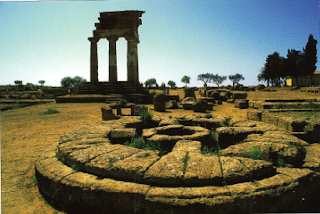For over sixty years scholars have attempted to pinpoint the context of what is arguably one of the most important archaeological discoveries in the last century. The Dead Sea Scrolls were discovered by accident, which lead to a larger search and later excavations of the sites by numerous groups.
These attempts to interpret and excavate the area of the scrolls' discovery has led to numerous interpretations in the academic, religious, and political spheres. Unfortunately the academic interpretations are heavily influenced by the latter two; the complex political affiliations in the area surrounding the Dead Sea has held this discovery as an emblem of the struggles in the area for historical supremacy and the use of the find as a sort of relic for the religious.
 |
| Coin of Herod the Great |
Since their discovery, the common association has been with the Essenes, a Jewish sect living in the area of the Dead Sea near Ein Gedi and with a known association with Qumran. Scholars have pointed to ancient writers Pliny and Josephus, who have mentioned similar location, traditions, and associations with the authors of the scrolls. It is, however, important to distinguish the differences between the authors of the scrolls, and the traditions associated with communities nearby. During the period the scrolls were authored (approximately 2nd c. BCE to 1st c. CE) many political changes in the region influenced their authorship. Hellenistic Kingdoms such as the Seleucids and Ptolemies had been vying over the region for centuries; local rulers such as the Hasmoneans and the Roman-sympathizing Herodian dynasty had struggled to keep the region in the hands of the people of Judea.
 |
| Book or Isaiah |
The context of the authorship also lies in the content of the scrolls themselves. The variety in the scrolls points to a massive library of theological literature as well as the establishment of rules of the community, as well as other texts of cultural importance. Traditional Hebrew religious texts are included, most notably the oldest surviving and most complete Book of Isaiah. Among the religious texts are commentaries, anthologies, and apocryphal texts of Hebrew theology. Other texts known as the "Community Rule" establishes correlations between known rituals and habits known of the Essenes such as ritual bathing and celibacy. Apocalyptic texts and the "War Scroll" establish a context of political disunity in the region. The breadth of the collection points to a well-established community of scholars existing over a period of a few centuries before the Roman destruction of Jerusalem. Some argue that the scrolls were hidden to evade the Romans, the mysterious "Copper Scroll" was hidden as a treasure-map.
 |
| Copper Scroll Fragment |
Although scholarship on the origin, authorship, and context of the scrolls is ongoing the discovery of the scrolls has allowed us to peer into a community whose voice has been silenced for two thousand years and perhaps further study may reveal hidden clues or revelations to this mysterious library.
























